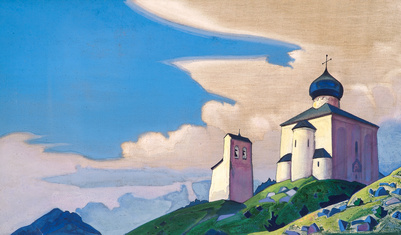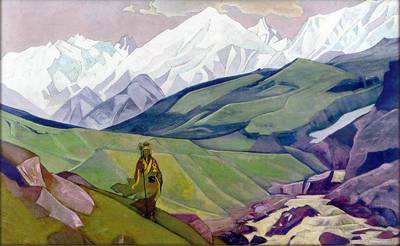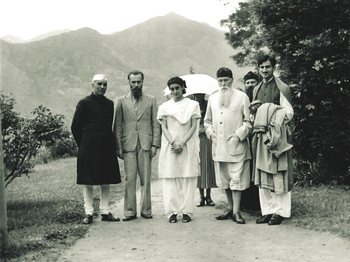INTERNATIONAL INTERDISCIPLINARY CONFERENCE «RUSSIA AND THE EAST: ART, PHILOSOPHY AND CULTURE»
Russian Academy of Arts
The International Centre of the Roerichs
Russian State University for the Humanities
The Institute of scientific information on social sciences (INION)
MPRH Institute (Tehran, Iran)
Bharat Institute (Chennai, India)
«RUSSIA AND THE EAST: ART, PHILOSOPHY AND CULTURE.
145 YEARS SINCE THE BIRTH OF ACADEMICIAN N. K. ROERICH,
115 YEARS SINCE the BIRTH of ACADEMICIAN S. N. ROERICH,
140 YEARS SINCE the BIRTH of E. I. ROERICH»
INTERNATIONAL INTERDISCIPLINARY CONFERENCE
Plenary meeting:
14–15 October 2019
Venue: Russian Academy of arts (Moscow, Russia)
Sessions:
«THE CREATIVE HERITAGE OF THE ROERICHS’ FAMILY: THE BRIDGE OF CULTURES»
9–10 October 2019
Venue: will be specified (Moscow)
«RUSSIA–INDIA: THE ART OF PHILOSOPHY. CULTURE»
23–24 October 2019
Venue: Kullu, India
2019 is the anniversary year for two remarkable Russian artists and thinkers whose creativity is the bridge between Russia and the East – academician Nicholas Roerich and his younger son academician Svyatoslav Roerich. Nicholas Roerichs’ wife, Helena Roerich, was an original thinker who combined in his work the philosophy of East and West.
Russia is a multi-ethnic country, which has united the West and the East in its geographical position and represents a special cultural world. Dostoyevsky spoke about the “worldwide responsiveness” of the Russian genius, in the act of creativity transform into images of other peoples, thereby absorbing their brightest and innermost sacred features.
On the one hand, art is thought of as a phenomenon of culture, the most “responsive” to external influences. Famous Russian artists – Vasily Vereshchagin, Nikolay and Svyatoslav Roerikhs, Pavel Kuznetsov, numerous artists-orientalists paint the East on the basis of personal impressions and perceived by the sensitive creative soul the Oriental myths and legends. On the other hand, the great masterpieces of art are “goodwill ambassadors” which carry the best aspirations of the national soul to the outside world, to the Treasury of world culture.
For Russia, the “Eastern dimension” is traditionally one of the determining. From the East to Russia came “the animal style”, later clearly manifested “the Oriental style” in Russian decorative art. This is evidence of deep processes, as the style by its nature reflect the existence of a stable construct in the mentality of culture, which is expressed in the works of painting, sculpture, architecture, etc.
Historically, Russia grew in the East, absorbing new trends in its Eastern territories and neighboring countries. Paintings by Nico Pirosmani, Martiros Sarian, sculptures and paintings by Zurab Tsereteli became an inseparable part of Russian culture.
In this conference we proposed to consider issues of intercultural and transcultural interaction in the multidimensional field of art, philosophy and culture.
Main topics of the conference:
Artistic, philosophical, social creativity of the Roerichs family as a bridge of cultures
Art (fine and decorative arts, architecture, landscape architecture, cinema) as a cultural phenomenon
Art as a way of cognition
Philosophy of art at the crossroads of cultures and civilizations
Russian philosophy: the Eastern turn
Philosophy of the East as the basis of modern cultural changes
Art as a way of storing and producing cognitive codes of culture
The influence of Russian culture on the art of the East
The influence of the cultures of the countries of the East in Russian art, “Oriental style” in Russian decorative art, Russian art orientalistische
Contemporary art at the crossroads of cultures and civilizations
«Indian trace» in Russian culture
Art, philosophy culture of Eastern regions and borders of Russia
Important date:
Deadline for abstract submission: August 1, 2019
The deadline for the invitation to the conference: 15 September 2019.
Working languages: Russian and English
Chairman of the organizing Committee – Dr. Olga Lavrenova
Email: olgalavr@mail.ru
Breakout session “Russia-India: Art. Philosophy. Culture”
of the International Interdisciplinary Conference “Russia-East: Art, Philosophy, Culture”,
23–24 October 2019, Kullu, India
The heart of India is turning to spanless Russia.
The great Indian magnet attracts the Russian hearts. Indeed,
“Altai – Himalayas” – two magnets, two balances, two foundations.
It makes you happy to see the viability of the Indian-Russian links.
Nikolas Roerich
We deeply respect Nicholas Roerich for his wisdom and creative genius.
We also appreciate him as a connecting link between the Soviet Union and India.
Indira Gandhi, Prime Minister of India
For as long as anyone can remember, the Russian people have always been attracted to India. This was reflected in the Old Russian literature (Alexandria, The Legend of the Indian Kingdom, The Story of Varlaam and Josaphat, etc.).
The Indo-Russian cultural interaction dates back to the XV century; it started with the travels of Afanasy Nikitin, the first Russian to visit India. From the XVIII century onwards, the Russians start to get increasingly drawn to the Indian culture. Soon after the first English translation of the Bhagavad Gitaappeared in 1785, the work was translated into Russian. In 1792 a prominent Russian historian Nikolay Karamzin translated one of India’s most remarkable literary works – Kalidasa’s Shakuntala.
Gerasim Lebedev’s journey to India in 1785–97 marked the birth of Russian Indology. Today, it is justly regarded as the strongest branch of the international oriental studies, which is due in no small part to the efforts of Yuri Roerich, the eldest son of the Roerichs, a brilliant Orientalist who revived the pre-revolutionary scientific tradition and the idea of steady and progressive transfer of knowledge from the teacher to the student in Russia in the late 1950s.
In the course of time, the Russian literature was enriched by literary translations of Indian verse and philosophic texts made by Vasily Zhukovsky, Konstantin Balmont and Jurgis Baltrušaitis. Many Russian thinkers were inspired by The Gospel of Sri Ramakrishna and Swami Vivekananda’s books, which had also been translated into Russian.
With its synthetic thought, high spirituality and its thousand-year history, India has always held a fascination for Russian artists. The paintings of Vasily Vereshchagin who made a journey to India late in the XIX century captured the multifaceted image of this beautiful land for the artist’s contemporaries – a tradition that is still followed by Russian artists today.
The great Russian cosmists Konstantin Tsiolkovsky, Vladimir Vernadsky, Alexander Chizhevsky drew on the Indian philosophy as a valuable source of knowledge for the modern fundamental science.
Having spent more than 60 years in India, the Roerichs attached great importance to Indian studies. The paintings by Nicholas and Svetoslav capture the rich landscapes of the Himalayas and the monuments of the ancient culture. Russian by birth, the Roerichs managed to penetrate the inner depths of the Indian spiritual tradition, the knowledge about the Great Masters and Their edification for the good of mankind. This knowledge became a cornerstone of the Living Ethics philosophy created by the Roerichs in cooperation with the Masters of the East.
In a small book titled “Foundations of Buddhism” (1927) Helena Roerich popularized for the Russian readers the ancient teachings that originated in India. The literary and philosophic essays written by Nicholas Roerich between 1930s and 1940s, such as Heart of Asia, India, Writings of Asia, are still relevant, and so are the entries from his Altai-Himalaya travel diary (1929).
Nicholas Roerich is one of the nine Indian artists whose paintings were recognised as India’s national assets. Nicholas Roerich celebrates India in various series of paintings, such as His Country (1924), Maitreya (1925), Sanctuaries and Citadels (1925) and Banners of the East(1925). In the words of Jawaharlal Nehru, “…these paintings [by Nicholas Roerich], so many of them of the Himalayas, … remind us of so much in our history, our thought, our cultural and spiritual heritage, so much not merely of the India of the past but of something that is permanent and eternal about India.”
The Indian Parliament building houses the portraits of the prominent politicians, Jawaharlal Nerhu and Indira Gandhi, painted by Svetoslav, the youngest son of the Roerichs. Just like his father, Svetoslav greatly contributed to the strengthening of the Russia-India ties, and even took them to a new level.
To this day, India has preserved the Roerichs’ places, such as their house in the Kullu Valley in India’s north, where the family lived between 1928 and 1947, and their house in southern India, in the Tataguni estate outside Bangalore, where Svetoslav Roerich lived for nearly half of a century together with his wife Devika Rani. The two countries will work together to build international cultural centres on these sites.
Kullu is also home to the Urusvati Himalayan Research Institute created by the Roerichs. To restore the Urusvati Institute will be critical for further development of science.
The works of Ludmila Shaposhnikova, a brilliant Russian Indologist, are also very important for the development of the present-day cultural and scientific ties. Ludmila Shaposhnikova wrote a total of 27 books and over 400 works on the creative and scientific activities of the Roerichs, as well as on the culture and history of India’s peoples. As Svetoslav Roerich’s confidante, she brought the Roerichs’ legacy to Russia, which eventually became the creative magnet for the development of scientific and cultural ties between Russia and India.
The modern scientific conferences, culture festivals and exhibitions that are held both in Russia and in India and bring together the two countries’ scientists, cultural figures, creative leaders and children, have long become an important mark of our times.
The breakout session will focus on various aspects of the legacy of the Roerichs and other members of the Russian creative and scientific community in terms of Russian-Indian cultural interaction:
– The image of India in the Russian culture;
– Indian inspirations in the paintings by Nicholas and Svetoslav Roerich;
– Indian inspirations in the works of Russian philosophers, literary artists and painters;
– Modern lines of interaction of the Russian and Indian art;
– The Great Indian Way in the context of the Central-Asian expedition of Nicholas Roerich;
– The works of Helena Roerich “Foundations of Buddhism” and “Cryptograms of the East”, her letters, and the importance of her works for the understanding of India’s culture and history;
– The concept of the Urusvati Institute and the issues related to its revival in the modern world;
– The Roerich Pact and India, the issues related to the preservation of the cultural heritage;
– The importance of the Roerichs’ historical and cultural legacy for the development of Indo-Russian ties, cooperation and the strengthening of peace between nations;
– Indologist and Roerich studies by Ludmila Shaposhnikova and their role in the modern cultural and scientific interaction between India and Russia.
– If your area of expertise is related to the topic of the conference, please submit your application. You are requested to indicate the subject of your contribution and your theses. The theses should be relevant to the subject and give a brief summary of your contribution. Each Contributor will be allotted 15 minutes at the Conference.
Submitting your theses:
Deadline for submitting the theses – no later than 1 September 2019.
Abstract volume – two to three pages, font size 14, 1.5 spaced.
The presentations will be selected on a competitive basis. Your participation in the conference will be confirmed before 15 September by a separate letter which shall be regarded as an invitation to the conference and may be used as a justification for a Business Trip Order.
All travel and accommodation costs shall be covered by the Contributor.
The registration fee is RUB 3,000 for the participants in the Conference from Russia and CIS states, and EUR 60 for the participants from other countries. The Contributors shall be exempt from the registration fee.
Please send your theses to Nadezhda Samoilova, Secretary of the Organizing Committee, at nadegda27@yandex.ru. For additional information, please contact us by telephone: +7 916 1559395.
Organizing Committee of the Conference
Read also the ICR site






